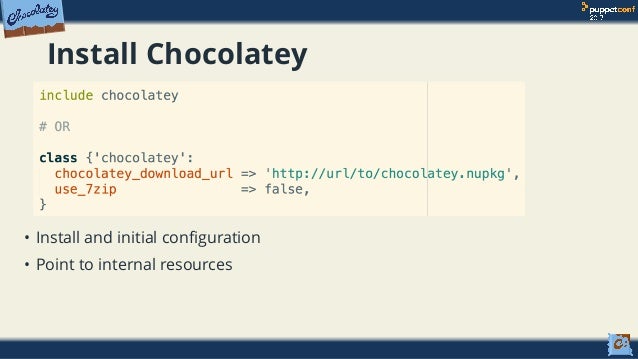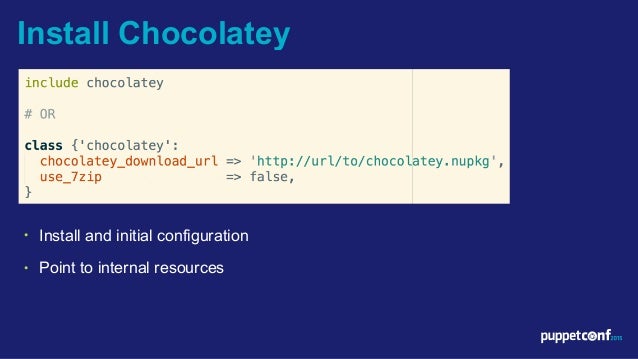Install Chocolatey
Share. LinkedIn. Facebook.
Install Chocolatey Windows 10
Twitter 0 It's 12:12 am on Monday morning and I've just accepted what feels like my 10th Microsoft EULA after fighting to re-install a fresh version of Windows 10 over my technical preview that I managed to keep running for the last 6 or so months. I can see the light at the end of the tunnel. The end of a marathon that started when I still had some of my Sunday afternoon ahead of me. This fresh Windows 10 installation is almost complete. Until I have to actually have to start installing 3rd-party software, that is. Finishing the Windows 10 install means two things happen in quick succession. First, tackling driver updates so my video card isn't showing me a 2001-era screen resolution.
Second is installing the myriad of 3rd-party software such as browsers, text editors, media players, etc. Required to be installed in order to get my PC to the point where I can actually use it. So continues the masochistic PC OS re-install ritual I've completed so many times before and am destined to repeat ad infinitum. Now, I'm sort of an edge-case user, though, so it's important to point out that most consumers don't actually have to deal with this but every few years (and that is being generous). I'm a web developer and computer hobbyist that goes through OS-installs quite a bit for things such as for virtual machines, a personal web server, Boot Camp on my Mac, and running technical previews alongside my stable OS builds. I'm on my fifth install for 2016 and I'm likely to complete a few more in 2017. There has to be a simpler way.
There's a brilliant package manager for Windows called and it provides a means for you to automate the installation of your 3rd-party software on the Windows platform. Similar to for.NET, for Linux, for Ruby, or for NodeJS (just to name a few), Chocolatey is a free, open-source platform that manages installation and removal of software packages maintained through a community-managed central library. That include additional benefits beyond basic package management, but this post will focus on the basic functionality provided in their free tier. What does this mean for you/me/humanity? For starters, I'm able to write this blog post while all the remaining 3rd party software installs in the background. Most importantly, we (yes, as in we, humanity) get to take advantage of the following enhancements to the PC OS-install experience:. Automated scripting for installing 3rd-party software when rebuilding Windows.
Running list of the software you installed with your last fresh copy of Windows. You get your life back. Sorta (a couple of hours, at least) I first learned about Chocolatey from the with the world. Check out his script if you want to know more about using Boxstarter to speed up your install process.
For the rest of this post, however, we'll use just Chocolatey. Let's jump in. Getting started with Chocolatey The rest of this post explains how to use Chocolatey for automating basic software package installation along the following primary topics:. Installing Chocolatey on Windows 10. Finding packages on. Putting together your install script Installing Chocolatey Before you can install any packages with Chocolatey, you first have to install the Chocolatey.exe file and add the `choco` command to the.

This can be a bit confusing for folks that aren't used to editing their PATH in Windows, so I recommend following along with the if you want to dig deeper. In the search results, the package name is shown in the skeoumorphic command line on the right half of the UI, with this particular package name listed plainly as `googlechrome`: C: choco isntall googlechrome Repeat this search process for each software package you want to install and take a note of each one. While you're looking through search results a few things are important to consider:. Number of downloads.
Package version (some packages might be unstable builds such as Google Chrome Canary). Is this package from a reputable source? It's important to call out that Chocolatey packages are published and maintained by the community. While I hope to think that this type of distribution platform won't be used for nefarious reasons, there isn't a foolproof way that I know of to prevent malicious packages from masquerading as the real deal. It's worth noting here, too, that Chocolatey implemented package moderation a few years back which is a huge positive step for trust in a community-managed ecosystem. Always be aware of where your software is coming from. Putting together your install script Now that we have Chocolatey installed and have a list of package names in the Chocolatey library, we need to combine them together into a single.bat file (or.sh file if you have already installed) and then set the script into motion.
To keep things simple, we'll use a.bat file as those can be run from a vanilla Windows installation. In addition to the Chocolatey install script and install commands for individual software packages, there are a number of other commands to allow you to further customize your PC available via. Your script will vary depending on which commands you decide to take advantage of.
Contents of this article. While people frequently use Chocolatey for personal devices, it is also an excellent tool to use for managing software for organizations. One of the great components of Chocolatey is the community software repository, which has over 5,800 unique Windows packages at the moment. For personal use, it is not a terrible idea to install packages from here directly.

However, an organization needs to use Chocolatey more in an offline fashion, without depending on the internet to manage their software. Many tasks in the article take information directly from. We will go through a few main steps:. Setting up an internal repository with Chocolatey Server. Configuring Chocolatey clients.
Internalizing community packages Setting up an internal repository with Chocolatey Server Chocolatey actually maintains a package that installs and configures an IIS web server. This services packages internally named 'Chocolatey Server' or 'Chocolatey Simple Server.' Personally, this is a great option for getting a repository up and running quickly. While you can install Chocolatey Server via Chocolatey itself, I prefer to do so via Puppet or another configuration management solution.
In this article I will do this via Chocolatey for the sake of simplicity. Choco upgrade chocolatey. Server -y - pre Chocolatey will add the IIS feature, create a site, and do some additional configuring to get it ready to be a feed.
It won't do all of the tasks you probably need though. So I recommend you do these tasks as well:.
Change the ApiKey in web.config. Set up basic authentication to restrict access to the IIS site. Install an SSL certificate After completing this, you have your own Chocolatey package feed that you can start populating with packages. Configuring Chocolatey clients To install the Chocolatey client software, we usually point to Chocolatey itself, which downloads the install script. Since we have Chocolatey Server set up (hostname choco-1), we can actually just point our clients there from PowerShell.
Choco config set virusCheckMinimumPositives 1 Internalizing community packages As I noted above, the Chocolatey community repository has over 5,800 Windows packages available. Organizations will likely want to use these existing packages for their own purposes, and can certainly do so. Licensed versions of Chocolatey offer the ability to internalize community packages automatically for private use. This downloads any installers from their internet distribution points and embeds them into the packages. After this, clients won't be reaching to the internet for any installers or resources.
Hello, I was looking to purchase a GTX 670 FTW (02G-P4-2678-KR) card from a 3rd party and was hoping to check the warranty status of the. Serial number lookup for guns. Is there a way to get the serial number of the NVIDIA cards without. Information on the Control Panel does not show the serial numbers. Sep 2, 2012 - Note: Note that this technique only works if the hardware manufacturer implements it. I can't give a percentage of accuracy, but I would guess. Jan 19, 2016 - Where is my graphics card serial number located at on my gpu the gpu is a gtx 960 geforce acx 2.0. Solved Where would you find AMD Ryzen serial number? Solved Where is my second serial number on MSI RX 480?
Here, I internalize Google Chrome from the community repository. Nupkg - source = https: / / choco -1 / chocolatey - api -key = 'myapikey' Conclusion While there are certainly other tasks organizations may execute for using Chocolatey internally, these show that setting up is not very difficult. Chocolatey is extremely agile with many great features.
The open source version of Chocolatey is perfectly suitable for organizational use. However, licensed versions provide additional features that help further automate package management tasks such as creating and internalizing software.





